Advanced Analytics for QuickBooks Desktop
Advanced Analytics for QuickBooks Desktop empowers you with financial analytical capabilities over your QuickBooks Desktop data. With this connector, you can create insightful reports & dashboards over your QuickBooks data for in-depth financial analysis. Hereafter, we refer this as QuickBooks Connector.
General
- What is Zoho Analytics?
- What is QuickBooks Advanced Analytics Connector?
- Who can subscribe to the QuickBooks connector?
- What do I get when I subscribe to this Connector?
Pricing
- How much does this connector cost?
- Do you provide trial evaluation for this connector?
- What do you mean by 'Users' in the (connector) pricing plan?
- What do you mean by 'Rows'/'Records' and how is it calculated in the pricing plan?
Setup
- What are the QuickBooks Desktop Versions on which the Zoho Analytics - QuickBooks Desktop integration works?
- How do I setup the QuickBooks Desktop Advanced Analytics Add-on?
- How long should I wait for my QuickBooks company data to initially appear in Zoho Analytics?
- In whose account will the QuickBooks connector be setup?
- How frequently can I synchronize my data with Zoho Analytics?
- How can I download the latest QWC file?
- How do I edit the setup?
- Can I set up the QuickBooks connector in any other existing Workspace or in any other analytics Workspace?
- Can I import data from multiple QuickBooks Companies?
- Can I set up the Connector in an account other than the one who configures/sets up the trial?
- Can I add/modify data in the QuickBooks Desktop data tables within Zoho Analytics?
- Can I add new columns to the QuickBooks Desktop data tables within Zoho Analytics?
- Can I add new data tables in this Workspace to create reports & dashboards?
- Can I transfer my QuickBooks Desktop connector to another admin account?
- How can I remove the setup?
Reporting Features
- What are the modules in QuickBooks on which I could create reports using this connector?
- How to create my own reports with this connector?
- Who has access to the reports I create?
- What are the report types supported by Zoho Analytics?
- What are the default reports & dashboards created by Zoho Analytics, on setting up this connector?
- Can I modify the default reports that have been created by this connector? If so, how?
- Can How do I create reports using fields/columns across different modules?
- What are 'Formulas' in reports?
- What are the default formulas added by Zoho Analytics, on setting up this connector?
- Can I combine data from other sources with the data from QuickBooks Desktop to create reports and dashboards?
- Can I join data from multiple tables to create reports?
- What are Query Tables?
Cross-Functional Analytics with Popular Business Applications
- What are the popular business applications that I can integrate this connector with?
- How can I analyze the data from the other business applications along with QuickBooks Company?
- Will a lookup relationship between the related modules from QuickBooks Desktop and other third-party applications be created automatically?
Users, Sharing & Collaboration
- How do I share the reports in Zoho Analytics with my colleagues?
- What are the user roles available in Zoho Analytics?
- Why can't other users edit the reports that I have shared to them?
- Can I share the same report created, to multiple users with different criteria associated so that they see different data?
- Can I export a report/dashboard?
- How can I print the reports & dashboards created in Zoho Analytics?
- How can I email reports & dashboards created in Zoho Analytics in a scheduled manner?
Solutions
Help & Support
FAQ & Troubleshooting Tips
FAQ
- What should I do if there is a connectivity issue?
- I got this email which said 'Setup Process Failed'/'Synchronization Process Failed'. What should I do?
- Where do I find the Installation Key in Zoho Analytics?
- How to change my Installation Key?
- I have renamed the company file in QuickBooks. Now I am unable to view the latest data in Zoho Analytics. What should I do?
Troubleshooting Tips
- I get an error message as "A QuickBooks company data file is already open and it is different from the one requested." How to resolve this?
- I get the error code QBWC1012. How to solve this?
- I get the error code QBWC1013. How to solve this?
- I get the error code QBWC1015. How to solve this?
- I get the error code QBWC1041. How to solve this?
- I get the error code QBWC1042. How to solve this?
- I get the error code QBWC1043. How to solve this?
- I get the error code QBWC1044. How to solve this?
- I get the error code QBWC1045. How to solve this?
- I get en error code QBWC1046. How to solve this?
General
1. What is Zoho Analytics?
Zoho Analytics is a self-service BI and data analytics software that lets you analyze your data, create stunning data visualizations, and discover hidden insights in minutes.
It offers the following important capabilities:
- Complete Online Business Intelligence and analytics service, accessible anytime, anywhere!
- Easy to adopt 'spreadsheet-like' interface with powerful drag & drop based reporting features for quick report creation.
- Visual Analysis capability for in-depth analysis and to slice & dice your data
- Supports a wide range of reporting capabilities like Dashboards, Charts, Pivot Tables, Summary Views and simple Tabular Views .
- Supports creation of KPI widgets in dashboards to analyze the performance.
- Supports data import from variety of file formats like Excel, JSON, HTML etc. Also supports data import from cloud storage and Web URLs. Supports periodic scheduling of imported data.
- Integrated with Zoho Finance apps (Zoho Books, Zoho Invoice, Zoho Inventory and Zoho Billing) to empower your organization data with the powerful reporting capabilities of Zoho Analytics.
- Integrated with a suite of Zoho products such as Zoho CRM, Zoho Desk, Zoho Projects, Zoho BugTracker, etc.
- Integrated with popular business applications like Google Analytics, Salesforce CRM etc.
- You can also integrate your own applications with Zoho Analytics using Zoho Analytics API.
- Integrated with Zapier to power up import from over 500+ apps.
- Integrated with Zoho Flow to power up import from over 300+ apps.
- Blend & merge data from across different sources to create meaningful business reports
- With an advanced formula engine, you can derive key business metrics from your data.
- Supports SQL (Structured Query Language) driven querying for powerful report creation.
- Real-time collaboration by sharing data and reports with your colleagues & friends, in either read or read-write modes.
- Export and Print reports in variety of formats. Notify reports via email.
- Publish reports for wider consumption. Embed reports within your websites, web applications and blogs.
- Highly secure through user login with support for HTTPS (SSL connection). All your data and reports are hosted in highly secure datacenters. (Refer Security and Privacy)
- Supports Logo Rebranding.
2. What is QuickBooks Advanced Analytics Connector?
QuickBooks Advanced Analytics Connector enables you to import your QuickBooks Desktop data into Zoho Analytics for advanced reporting and analysis. This connector brings in all the capabilities of Zoho Analytics described above to QuickBooks users.
- A full-featured business intelligence (BI) and analytics tool that can slice & dice your QuickBooks data to create any report/dashboard you require.
- Over 50+ handpicked reports/dashboards that anyone using QuickBooks will find great value in.
- Create your own reports and dashboards based on not only your QuickBooks data but also from any other data sources and popular business applications.
- Share reports and dashboards with your colleagues.
- Schedule and email your reports whenever you want.
- Export your reports as PDF, HTML, Excel, CSV and image files.
- Embed your reports in websites, blogs etc.
3. Who can subscribe to the QuickBooks connector?
Any QuickBooks Desktop user who is an Administrator of the company in QuickBooks can configure this connector to analyze their QuickBooks company data. Please note that only one setup is allowed per company in Zoho Analytics.
4. What do I get when I subscribe to this Connector?
As a QuickBooks Desktop user, subscribing to this connector brings you immense benefits. You get to look at your data in QuickBooks in ways you haven't looked at before. Using this Zoho Analytics connector enables you to do powerful analysis of your QuickBooks Desktop data and create insightful reports & dashboards. You can create reports like Bills trend by count, outstanding revenue details, Purchase order funnel and much more with ease.
Zoho Analytics drag-and-drop based reporting is so easy to use that you could create any report or dashboard on your QuickBooks data with no IT help or technical knowledge and share them to your colleagues.
Pricing
1. How much does this connector cost?
QuickBooks Desktop Analytics is bundled free for all the paid users of Zoho Analytics. The Zoho Analytics paid plans starts at per month. Click to learn more about Zoho Analytics pricing.
2. Do you provide trial evaluation for this connector?
Yes, we do provide a 15-day free trial for this connector from the date of setup.
3. What do you mean by 'Users' in the (connector) pricing plan?
Anyone to whom you privately share your Workspace, tables (data), reports and dashboards, created in Zoho Analytics for collaboration is considered a 'User' in Zoho Analytics. A user is identified by his/her unique email address, with which their Zoho Analytics account was registered.
Suppose you subscribe to the Zoho Analytics Standard plan, you can privately share the data/reports in your account and collaborate with 4 other persons. Now your Zoho Analytics account is said to have 5 users (including yourself).
4. What do you mean by 'Rows'/'Records' and how is it calculated in the pricing plan?
In Zoho Analytics, a row or record is defined in the same context as in a database (or spreadsheet). In simple terms, a table consists of rows (records) and columns (fields). Each row in a table represents a set of related data and has the same structure. For example, in a table that represents "invoice", each row would represent a single invoice record. The number of rows calculated for pricing is the sum of all rows/records stored across all your Workspace tables in your Zoho Analytics account.
Setup
1. What are the QuickBooks Desktop Versions on which the Zoho Analytics - QuickBooks Desktop integration works?
You can set up the Zoho Analytics-QuickBooks Desktop integration if your QuickBooks Desktop belongs to one of the below versions:
QuickBooks Web Connector 2.1.0.30 and older versions:
- U.S. editions of QuickBooks Financial Software products
- QuickBooks Enterprise Solutions
- QuickBooks Premier (2002 or later)
- QuickBooks Pro (2002 or later)
- Canadian editions of QuickBooks Pro, Premier or Enterprise (2003 or later)
- UK editions of QuickBooks Pro or Accountant Edition (2003 or later)
QuickBooks Web Connector 2.2.0.34 and newer versions:
- U.S. editions of QuickBooks Financial Software products
- QuickBooks Enterprise Solutions (2015 or later)
- QuickBooks Premier (2015 or later)
- QuickBooks Pro (2015 or later)
- Canadian editions of QuickBooks (2015 or later)
- UK editions of QuickBooks (2015 or later)
2. How do I setup the QuickBooks Desktop Advanced Analytics Add-on?
3. How long should I wait for my QuickBooks company data to initially appear in Zoho Analytics?
Initial data import will take from few minutes to a couple of hours, depending on the volume of the data. You will receive an email notification once the import is complete. If you access the Workspace before the initial fetch, it will not display any data.
4. In whose account will the QuickBooks connector be setup?
It will be set up in the corresponding Zoho Analytics account of the QuickBooks Administrator who configured this connector. Only one Zoho Analytics setup per company is allowed.
5. How frequently can I synchronize my data with Zoho Analytics?
You can schedule to synchronize data either from Zoho Analytics interface or from QuickBooks Web Connector.
Schedule from Zoho Analytics
You can choose to schedule form from Zoho Analytics using the Import wizard or Edit Setup dialog. This allows you to schedule once in every 24 hours.
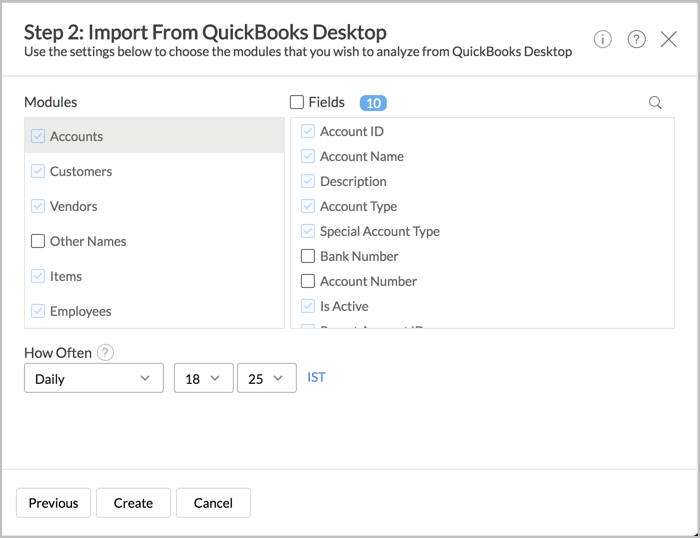
QuickBooks Web Connector
The QuickBooks Web Connector allows you to schedule every n minutes. To schedule data synchronization, select the Auto-Run checkbox and specify the interval you want to import in Every-Min drop-down.
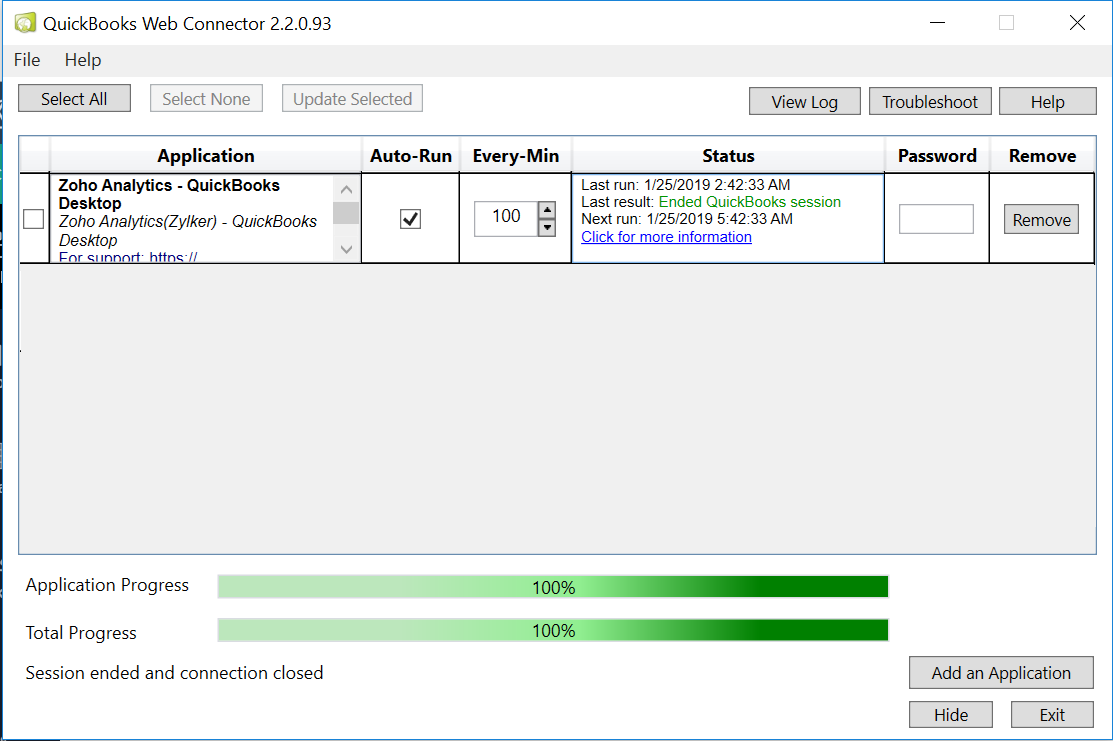
6. How can I download the latest QWC file?
You can download the QWC file any time, even after setting up the connector. To download the latest QWC file,
- Open the QuickBooks Desktop Advanced Analytics Workspace.
- Click the Data Source in the Explorer.
- In the Data Sources tab that opens, click the Download .QWC File link. The QWC file will get downloaded.

7. How do I edit the setup?
Yes, you can edit the QuickBooks connector synchronization setting if you are the administrator of the Zoho Analytics account. To do so,
- Open the QuickBooks Advanced Analytics Workspace.
- Click the Data Sources button in the left panel. The Data Sources page that opens.
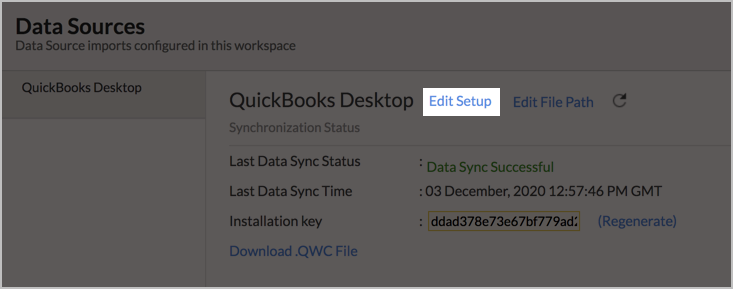
- Click the Edit Setup link.
- Make the necessary changes and click Save.
9. Can I set up the QuickBooks connector in any other existing Workspace or in any other analytics Workspace?
Yes, you can set up the QuickBooks Desktop Analytics in any of the existing Workspaces (including the Advanced Analytics Workspaces of other Connectors), to analyze data together. You can do this by invoking New Table / Import Data.
10. Can I import data from multiple QuickBooks Companies?
Yes, you can configure multiple QuickBooks companies. You need to create different workspaces for each QuickBooks company.
11. Can I set up the Connector in an account other than the one who configures/sets up the trial?
Yes, you can do this after the sync is deleted for the previous account. In this case, you will not be able to trial again. To set up the synchronization in the new account you need to purchase Zoho Analytics.
12. Can I add/modify data in the QuickBooks Desktop data tables within Zoho Analytics?
No, you cannot add/modify data in the QuickBooks Desktop data tables. Data from QuickBooks Desktop application will automatically get synced into Zoho Analytics in the different tables. You cannot edit any of this data or add new data records from within Zoho Analytics.
However, you can add new tables and add/import data into them to create reports combining it with the data from QuickBooks Desktop.
13. Can I add new columns to the QuickBooks Desktop data tables within Zoho Analytics?
No, you cannot add new columns. However, you can add Custom and Aggregate Formulas (i.e., calculated fields) to these tables to help you create powerful reports. Refer Adding Formulas to know more about this topic.
14. Can I add new data tables in this Workspace to create reports & dashboards?
Yes, you can add new data tables. Click Create New Table/Import Data to add a new table in the existing QuickBooks Desktop Workspace. With this feature, you can import data from other sources or add them manually into your Workspace to analyze and create reports combining this with your QuickBooks Desktop data.
Refer:
- How to Import data from files and feeds into Zoho Analytics
- How to Import data from local databases
- How to Import from cloud databases
- How to Import data using Zoho Analytics API
15. Can I transfer my QuickBooks Desktop connector to another admin account?
For now, we don't provide an option in the user interface. If you require this transfer, please mail us at support@zohoanalytics.com. We will get your requirements and handle this.
16. How can I remove the setup?
To remove the setup,
- Login to your Zoho Analytics account.
- Open the corresponding Workspace.
- Click Data Sources button.
- In the Data Sources page that opens click the Settings icon and then select Remove Data Source.
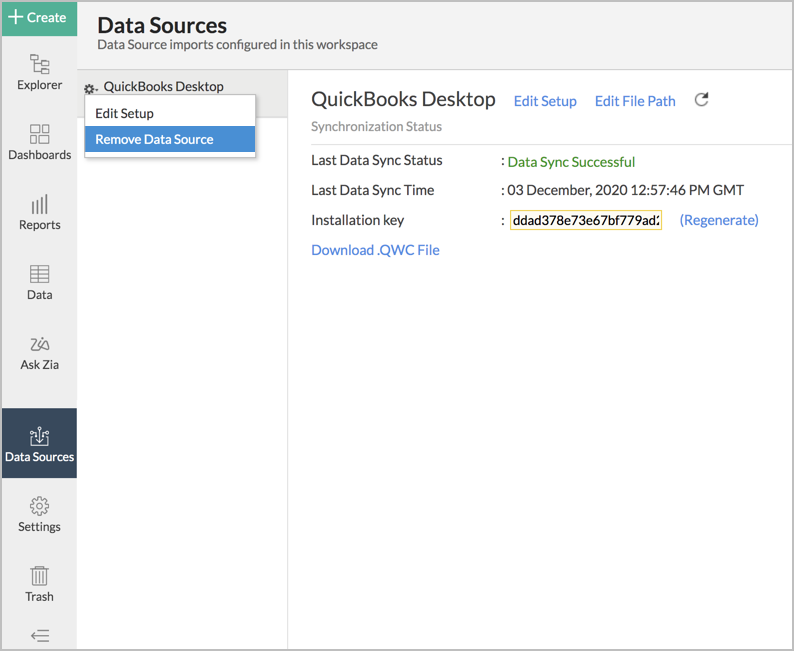
Reporting Features
1. What are the modules in QuickBooks on which I could create reports using this connector?
Data from the following modules in QuickBooks will get synchronized with Zoho Analytics.
- Accounts
- Bill Line Items
- Bill Payments
- Bills
- Check Line Items
- Checks
- Classes
- Credit Memo Line Items
- Credit Memos
- Customers
- Deposit Line Items
- Deposits
- Employees
- Estimate Line Items
- Estimates
- Invoice Line Items
- Invoices
- Items
- Journal Entries
- Journal Entry Line Items
- Other Names
- Payment Methods
- Payments
- Payroll Item Wages
- Purchase Order Line Items
- Purchase Orders
- Sales Order Line Items
- Sales Orders
- Sales Receipt Line Items
- Sales Receipts
- Sales Rep
- Sales Tax Codes
- Transfers
- Terms
- Vendor Credit Line Items
- Vendor Credits
- Vendors
2. How to create my own reports with this connector?
You can refer to the below presentation to know how to create your own reports & dashboards using Zoho Analytics.
Also refer:
Note
For creating your own reports using this connector, you must be the Account Administrator or the Workspace Administrator.
3. Who has access to the reports I create?
By default, the reports you create are accessible only to you. However, you can share the reports with your colleagues using the 'Sharing' options available in Zoho Analytics. Refer How to Share Reports & Dashboards question.
4. What are the report types supported by Zoho Analytics?
Zoho Analytics supports a wide variety of reports.
- Charts
- Pie
- Bubble
- Packed Bubble
- Bar
- Stacked bar
- Line
- Smooth Line
- Scatter
- Combination
- Map Chart
- Area
- Stacked Area
- Web
- Funnel
- Doughnut
- Table View
- Pivot tables (Matrix Views)
- Summary view
- Tabular view
- KPI Widgets
- Single Numeric Widget
- Dial Chart Widget
- Bullet Chart Widget
- Dashboards (multiple reports arranged in the same page)
5. What are the default reports & dashboards created by Zoho Analytics, on setting up this connector?
When you set up/configure the QuickBooks Integration Connector, 50+ default reports & dashboards are automatically created. These hand-picked reports will be pretty useful in analyzing your Books company data effectively.
You can quickly review the default reports from the QuickBooks Advanced Analytics Sample Workspace.
6. Can I modify the default reports that have been created by this connector? If so, how?
Yes, you can modify the default reports. If you are the 'Account Administrator' or a 'Workspace Administrator' of the Zoho Analytics account in which the Connector is configured (Refer Managing Users in Zoho Analytics). To modify the reports click the Edit Design button in a report's toolbar and you will be able to make the changes. If you are just a user who's been shared the report, save a copy of the report by clicking the Save As icon. Now you can edit this new copied report.
7. How do I create reports using fields/columns across different modules?
Columns from across different QuickBooks modules are joined by default. Therefore, you can create reports by simply dragging and dropping the respective columns.
8. What are 'Formulas' in reports?
Formulas, as the name indicates, are calculations that help you derive key business metrics that can be used for reporting and analysis. Zoho Analytics provides a powerful formula engine to create any type of calculations required, to enable creating the required reports. Refer Adding Formulas in Zoho Analytics to know more.
9. What are the default formulas added by Zoho Analytics, on setting up this connector?
You can also add your own formulas to derive your own calculations. Do refer to Adding Formulas in Zoho Analytics help page. You can view these formulas by opening the corresponding table and selecting Add>Edit Formulas.
The below table lists all the default formulas that will be created in the Bill Line Items table
| Formula Name | Formula | Formula Type | Description |
| Amount(BCY) | If(Isnull("Exchange Rate"), "Amount","Amount"*"Exchange Rate") | Formula Column | Returns the amount in home currency value for each bill line item. |
The below table lists all the default formulas that will be created in the Bill Payments table.
| Formula Name | Formula | Formula Type | Description |
| Bill Payment Amount(BCY) | if( Isnull ("Amount(BCY)"),"Amount","Amount(BCY)") | Formula Column | Returns the amount in home currency value for paid bills. |
The below table lists all the default formulas that will be created in the Bills table.
| Formula Name | Formula | Formula Type | Description |
A/P Age Tier
| if("A/P Age in Days"<=0,'Current',if("A/P Age in Days"<=30,'1 - 30 days', if("A/P Age in Days"<=60,'31 - 60 days', if("A/P Age in Days"<=90,'61 - 90 days', if("A/P Age in Days"<=180,'91 - 180 days','Above 180 days'))))) | Formula Column | This categorizes AP Age Tier as follows a) 1-30 days - AP Age Tier of less than 30 days |
| AP AgeType | if("A/P Age in Days"<=0,'Due','OverDue') | Formula Column | Verifies and returns whether the bill is overdue or not. |
| AP Age in Days | datediff( currentdate( ),"Due Date") | Formula Column | Returns the number of days available to pay the outstanding bill amount to vendors. |
| Due(BCY) | If(Isnull("Amount Due(BCY)"), "Amount Due", "Amount Due(BCY)") | Formula Column | Returns the total Bill amount in home currency value. |
Paid Status
| If("Is Paid" =1, 'Paid','Unpaid')
| Formula Column | Verifies the bill status and returns whether it is Paid or Unpaid. |
The below table lists all the default formulas that will be created in the Check Line Items table
| Formula Name | Formula | Formula Type | Description |
| Amount(BCY) | If(Isnull("Exchange Rate"), "Amount","Amount"*"Exchange Rate") | Aggregate | Returns the amount in home currency value for each check line item. |
The below table lists all the default formulas that will be created in the Checks table.
| Formula Name | Formula | Formula Type | Description |
| Check Amount(BCY) | If(Isnull("Amount(BCY)"), "Amount", "Amount(BCY)") | Aggregate | Returns the total check amount in home currency value. |
The below table lists all the default formulas that will be created in the Credit Memo Line Items table.
| Formula Name | Formula | Formula Type | Description |
| Total(BCY) | If(Isnull("Exchange Rate"), "Total","Total"*"Exchange Rate") | Aggregate | Returns the amount in home currency value for each credit memo line item. |
The below table lists all the default formulas that will be created in the Credit Memos table.
| Formula Name | Formula | Formula Type | Description |
| Customer Credit(BCY) | If(Isnull("Credit Remaining(BCY)"),"Credit Remaining", "Credit Remaining(BCY)") | Formula Column | Returns the total credit memo amount in home currency value. |
The below table lists all the default formulas that will be created in the Deposit Line Items table.
| Formula Name | Formula | Formula Type | Description |
| Amount(BCY) | If(Isnull("Exchange Rate"), "Amount","Amount"*"Exchange Rate") | Aggregate | Returns the amount in home currency value for each deposit memo line item. |
The below table lists all the default formulas that will be created in the Deposits table.
| Formula Name | Formula | Formula Type | Description |
| Amount(BCY) | If(Isnull("Deposit Amount(BCY)"), "Deposit Amount", "Deposit Amount(BCY)") | Aggregate | Returns the total deposit amount in home currency value. |
The below table lists all the default formulas that will be created in the Estimate Line Items table.
| Formula Name | Formula | Formula Type | Description |
| Total(BCY) | If(Isnull("Exchange Rate"), "Total","Total"*"Exchange Rate") | Aggregate | Returns the amount in home currency value for each estimate line item. |
The below table lists all the default formulas that will be created in the Estimates table.
| Formula Name | Formula | Formula Type | Description |
| Amount(BCY) | if(Isnull("Total Amount(BCY)"),"Total Amount","Total Amount(BCY)") | Aggregate | Returns the total estimate amount in home currency value. |
The below table lists all the default formulas that will be created in the Invoice Line Items table.
| Formula Name | Formula | Formula Type | Description |
| Total(BCY) | If(Isnull("Exchange Rate"), "Total","Total"*"Exchange Rate") | Aggregate | Returns the amount in home currency value for each invoice line item. |
The below table lists all the default formulas that will be created in the Invoices table.
| Formula Name | Formula | Formula Type | Description |
| A/R Age Type | if("A/R Age in Days"<=0,'Due','OverDue') | Aggregate | Verifies and returns whether the invoice is overdue or not. |
A/R Age in Days = | datediff( currentdate( ),"Due Date")= | Aggregate | Returns the number of days available to collect the outstanding invoice amount from customers. |
AR Age Tier
| if("A/R Age in Days"<=0,'Current',if("A/R Age in Days"<=30,'1 - 30 days', if("A/R Age in Days"<=60,'31 - 60 days',if("A/R Age in Days"<=90,'61 - 90 days', if("A/R Age in Days"<=180,'91 - 180 days','Above 180 days'))))) | Aggregate | This categorizes AR Age Tier as follows a) 1-30 days - AR Age Tier of less than 30 days |
| Amount (BCY) | (if("Applied Amount"<0,"Applied Amount"*-1,"Applied Amount")+"Balance")*"Exchange Rate" | Aggregate | Returns the total invoice amount in home currency value. |
| Invoice Balance(BCY) | if(Isnull("Balance(BCY)"),"Balance","Balance(BCY)") | Aggregate | Returns the total invoice balance amount in home currency value. |
The below table lists all the default formulas that will be created in the Journal Entry Line Items table.
| Formula Name | Formula | Formula Type | Description |
| Amount(BCY) | If(Isnull("Exchange Rate"), "Amount","Amount"*"Exchange Rate") | Aggregate | Returns the amount in home currency value for journey entry line item. |
The below table lists all the default formulas that will be created in the Payments table.
| Formula Name | Formula | Formula Type | Description |
| Amount(BCY) | If(Isnull("Total Amount(BCY)"),"Total Amount", "Total Amount(BCY)") | Aggregate | Returns the total invoice payment amount in home currency value. |
The below table lists all the default formulas that will be created in the Purchase Order Line Items table.
| Formula Name | Formula | Formula Type | Description |
Amount(BCY) | If(Isnull("Exchange Rate"), "Amount","Amount"*"Exchange Rate") | Aggregate | Returns the amount in home currency value for each purchase order line item. |
The below table lists all the default formulas that will be created in the Purchase Orders table.
| Formula Name | Formula | Formula Type | Description |
| Amount(BCY) | If(Isnull("Total Amount(BCY)"), "Total", "Total Amount(BCY)") | Aggregate | Returns the total purchase orders amount in home currency value. |
The below table lists all the default formulas that will be created in the Sales Order Line Items table.
| Formula Name | Formula | Formula Type | Description |
| Amount(BCY) | If(Isnull("Exchange Rate"), "Amount","Amount"*"Exchange Rate") | Aggregate | Returns the amount in home currency value for each sales order line item. |
| Expeceted Sales | Yet To Order Item Qty | Aggregate | Returns the expected sales. |
| Yet To Order Item Qty | if("Quantity"<"Invoiced"<0,0,"Quantity"-"Invoiced") | Aggregate | Returns the number of pending Items to be ordered. |
The below table lists all the default formulas that will be created in the Sales Orders table.
| Formula Name | Formula | Formula Type | Description |
| Amount(BCY) | if(Isnull("Total Amount(BCY)"),"Total Amount","Total Amount(BCY)") | Formula Column | Returns the total sales orders amount in home currency value. |
The below table lists all the default formulas that will be created in the Sales Receipt Line Items table.
| Formula Name | Formula | Formula Type | Description |
| Total(BCY) | If(Isnull("Exchange Rate"), "Total","Total"*"Exchange Rate")" | Formula Column | Returns the amount in home currency value for each sales receipt line items. |
The below table lists all the default formulas that will be created in the Sales Receipts table.
| Formula Name | Formula | Formula Type | Description |
| Amount(BCY) | If(Isnull("Total Amount(BCY)"), "Amount", "Total Amount(BCY)") | Formula Column | Returns the total sales receipt amount in home currency value. |
The below table lists all the default formulas that will be created in the Vendor Credit Line Items table.
| Formula Name | Formula | Formula Type | Description |
| Amount(BCY) | If(Isnull("Exchange Rate"), "Amount","Amount"*"Exchange Rate") | Formula Column | Returns the amount in home currency value for each vendor credit line items. |
The below table lists all the default formulas that will be created in the Purchase Order table.
| Formula Name | Formula | Formula Type | Description |
| Vendor Credits | If(Isnull("Credit Amount(BCY)"),"Credit Amount", "Credit Amount(BCY)") | Formula Column | Returns the total sales purchase order amount in home currency value. |
10. Can I combine data from other sources with the data from QuickBooks Desktop to create reports and dashboards?
Yes, you can combine data from your other sources with your QuickBooks Desktop data for analysis.
To do this, you need to create a new data table into the QuickBooks Desktop Workspace and then define a look-up to join it with the table from QuickBooks Desktop.
To define a lookup relationship between two tables, it is essential that the tables have at least one column which is common between them.
Follow the below steps to look up a column from QuickBooks Desktop along with the data from any other source.
- Open the corresponding table, right-click the column header and select Change to Lookup Column.
- In the Change to Lookup Column dialog that opens, select the column to look up.
- Click OK.
Click to learn more.
11. Can I join data from multiple tables to create reports?
Yes, you can join data from multiple tables to create the reports. Refer to Joining Tables in Zoho Analytics for detailed help on this.
12. What are Query Tables?
Zoho Analytics allows you to drive the data required by writing standard SQL SELECT Queries. This feature is called Query Tables. With Query Tables, you can also combine data from different tables and create reports from the same. View this video demo to know about how to create Query Tables in Zoho Analytics.
Cross-Functional Analytics with Popular Business Applications
1. What are the popular business applications that I can integrate this connector with?
You can integrate and perform cross-functional analytics with most business applications that Zoho Analytics integrates with.
2. How can I analyze the data from the other business applications along with QuickBooks Company?
To import data from business apps,
- Open the Workspace in which you have set up the QuickBooks connector.
- Click the New Table/Import Data button.
- In the Create New Table tab that opens, select the application that you wish to import.
- Provide the necessary authentications.
- Select the necessary modules and fields.
- Select the schedule import option.
- Click Create. Data from the selected application will be imported into a new table in the QuickBooks Desktop Analytics workspace.
3. Will a lookup relationship between the related modules from QuickBooks Desktop and other third-party applications be created automatically?
A lookup relationship will not be created automatically between the QuickBooks Desktop modules and the modules of the application that you are trying to import. You will have to manually link the tables using a lookup relationship.
To manually create a lookup relationship refer this help link -
https://www.zoho.com/analytics/help/table/joining-tables.html
Users, Sharing & Collaboration
1. How do I share the reports in Zoho Analytics with my colleagues?
You can easily share the reports that you create with the other users in your organization. Refer to Sharing and Collaboration help page for more details on this.
Once you privately share a report to your colleagues they will be able to access the reports as you do. Refer here to know how to access the reports.
2. What are the user roles available in Zoho Analytics?
Zoho Analytics offers three user roles - Account Administrator, Workspace Administrator, and User. Click to know more about the Zoho Analytics Organization Model and User Roles.
3. Why can't other users edit the reports that I have shared to them?
This is the expected behavior. Only when the users to whom the reports are being shared is set as a Workspace Administrator, they will be able to edit the reports. If a normal user wants to edit the report, he/she will have to save the report with a new name using the Save As option toolbar. The User can edit this report. To know more about user roles click here.
4. Can I share the same report created, to multiple users with different criteria associated so that they see different data?
Yes, you can. Refer the topic Apply filter criteria.
5. Can I export a report/dashboard?
Yes, you can export the report/dashboard in various file formats such as CSV, EXCEL, PDF, HTML, and Image. Click to know more.
6. How can I print the reports & dashboards created in Zoho Analytics?
In order to print the report/dashboard, you first need to export it. You can export the report in various file formats such as CSV, EXCEL, PDF, HTML and Image. Click to know more.
7. How can I email reports & dashboards created in Zoho Analytics in a scheduled manner?
If you are the Administrator of the Zoho Analytics or a 'Workspace Administrator', you can schedule reports and dashboards to be emailed automatically. Refer to the email schedule section in this help documentation.
Solutions
1. Does Zoho Analytics offer Embedded Analytics or rebranding?
Yes, Zoho Analytics supports various rebranding options such as Portal rebranding/white labeling and Logo Rebranding.
Help & Support
1. How do I get technical support on Zoho Analytics?
We offer 24x5 technical support (Monday to Friday). In case if you need our assistance kindly do mail us your questions to support@zohoanalytics.com.
You can also reach out to us on our toll-free numbers -
United States: +1 (888) 900 9646
United Kingdom: +44 (20) 35647890
Australia: +61-2-80662898
India: 044 - 69656060
2. Can I have someone from Zoho do a demo for me?
Yes, certainly. Register for a demo in this page.
FAQ & Troubleshooting Tips
FAQ
1. What should I do if there is a connectivity issue?
Connectivity issues can arise due to multiple reasons. Ensure that there is an Internet connection between the QuickBooks Connector and Zoho Analytics. Verify if the QuickBooks Desktop company file is present in the file path that is mentioned. If the connectivity issue persists, write to us at support@zohoanalytics.com. Our support team will analyze the case and get back to you.
2. I got this email which said 'Setup Process Failed'/'Synchronization Process Failed'. What should I do?
The import/sync process of your QuickBooks Desktop data can sometimes fail due to a variety of reasons. Hence, you may receive such mails occasionally. The Zoho Analytics team will look into it immediately and get back to you, after taking the required corrective action.
Case 1: You will receive the Setup Process Failed mail when there is a failure during the initial fetch. In this case, we request you to write to us at support@zohoanalytics.com. We will look into it and get back to you immediately.
Case 2: You will receive the Synchronization Failed mail if there is any failure during the data synchronization process between QuickBooks Desktop and Zoho Analytics, after the initial setup & import of data. This might be a momentary failure due to any internal issues. This import schedule will get suspended if there are five successive failures.
3. Where do I find the Installation Key in Zoho Analytics?
The installation key will be available in the following places in Zoho Analytics:
You can find your Installation Key on the final page of your import wizard.
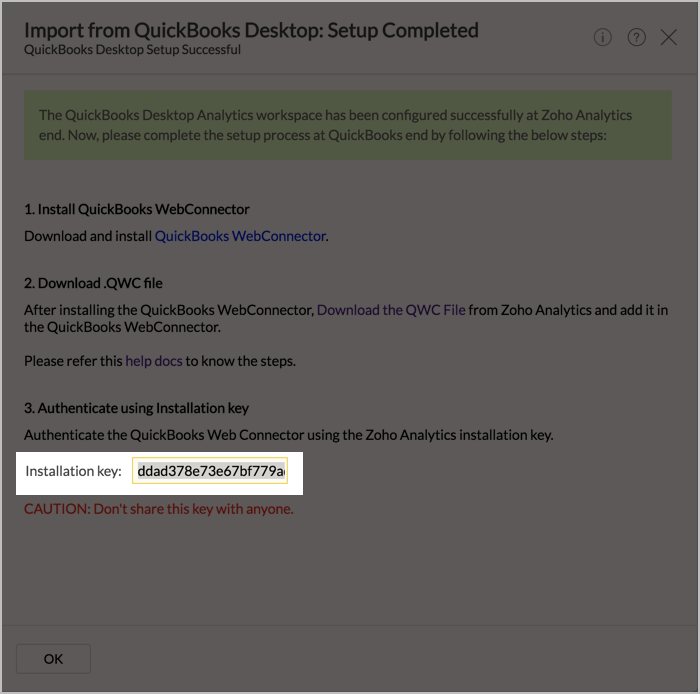
Once the initial setup is ready, the key will be available in the QuickBooks Desktop Data Sources page.

4. How to change my Installation Key?
To change your Installation Key, follow the below steps:
- Open your QuickBooks Desktop Data Sources page.
- Click the Regenerate link inline to Installation key.

- In the Caution - Regenerating Installation Key dialog that opens, click Yes to confirm.

Your new installation key will be generated successfully.
Note: Once the new key is generated, the old installation key will not be valid. You need to update the new key in your QuickBooks Web Connector application as well.
5. I have renamed the company file in QuickBooks. Now I am unable to view the latest data in Zoho Analytics. What should I do?
You need to edit the file path in Zoho Analytics to view the renamed company file. To do so,
- Open your QuickBooks Desktop Data Sources page.
- Click the Edit File Path link.
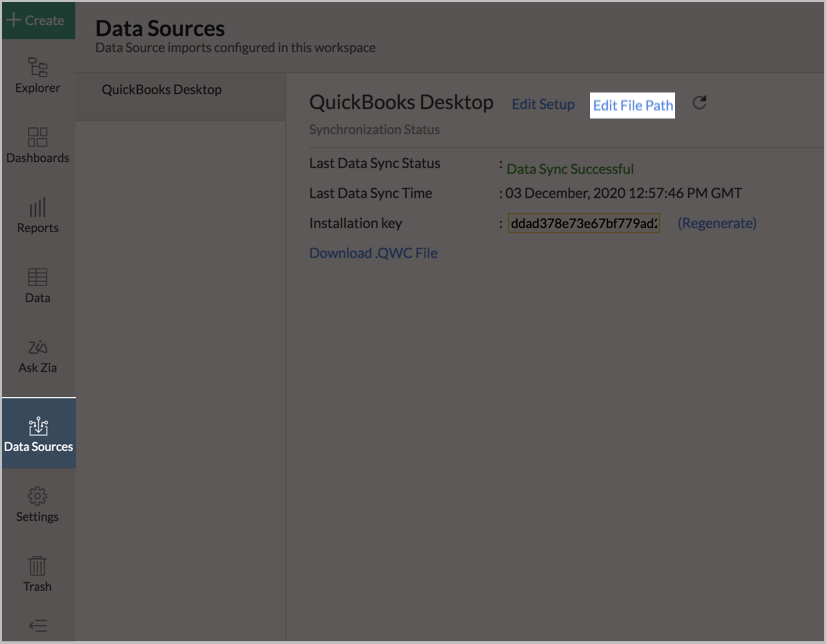
- In the Edit QuickBooks Company File Path dialog that appears, change the file path and click Save.
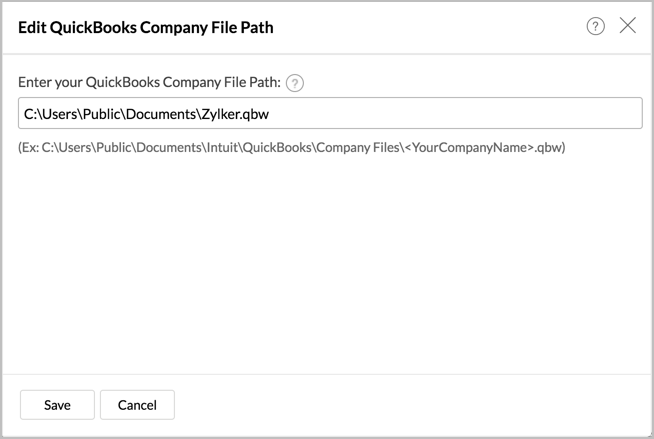
- Download the new .QWC file from the Download QWC file link available on the Data Sources page.
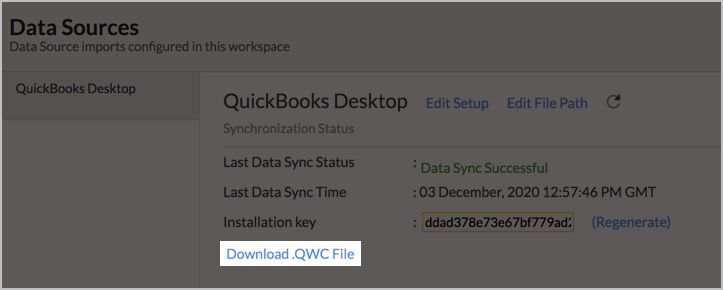
- Remove the existing application in the QuickBooks Web Connector and add the new file.
Troubleshooting Tips
1. I get an error message as "A QuickBooks company data file is already open and it is different from the one requested." How to resolve this?
The following are the possible causes that can result in this error.
Case 1: You have two instances of QuickBooks open on the same machine.
Solution: Run only one instance & close all other instances.
Case 2: You have the Quick Start option turned on.
Solution: Turn off this option.
Case 3: Different QuickBooks File is open. You have QuickBooks open to a particular company file other than the one you had originally set up in the Zoho Analytics Setup Creation Configuration page. Trying to refresh data from a different QuickBooks File will cause this error. This generally occurs on a single-user installation.
Solution: Ensure that the file specified in Zoho Analytics Setup page and the one that is opened are same using the Edit Setup option.
Case 4: Different QuickBooks Path. You have QuickBooks open to a particular company file that is using a different path than the one you had originally set up in the Qube Configuration Tool. Trying to refresh data from a different QuickBooks path will cause this error. This generally occurs on a single-user installation.
Solution: Ensure that the Company which is configured in Zoho Analytics alone is opened.
2. I get the error code QBWC1012. How to solve this?
Message: Authentication failed due to the error message: <An error message appears here>.
Cause: Got an exception during the authenticate() call to the application. This could be either a client or a server side problem.
Solution: There is an error in the web application definition. Please send the following to our Support Team.
- A screenshot of this error message.
- The QWCLog.txt file. The default location is C:\Documents and Settings\All Users\Application Data\Intuit\QuickBooks Web Connector\version directory.
- A dump of the web connector registry settings.
3. I get the error code QBWC1013. How to solve this?
Message: Error connecting to QuickBooks. Returning error message to the application.
Cause: QuickBooks web connector makes an attempt to connect to QuickBooks during update operation.
This error code represents the fact that a failure occurred during this connection attempt. Note that you can get this error if QuickBooks is running on Vista with UAC turned off.
Solution: Please send the following to our support Team.
- A screenshot of the status window.
- The QWCLog.txt file default path is C:\Documents and Settings\All Users\Application Data\Intuit\QuickBooks Web Connector\version directory.
4. I get the error code QBWC1015. How to solve this?
Cause: Exception occurred during Close Connection call from QuickBooks web connector to QuickBooks.
Solution: Data import is completed, but QuickBooks web connector could not end its communication with QuickBooks. To solve this, sent the information stated for error QBWC1012 to our support team.
5. I get the error code QBWC1041. How to solve this?
Message: Got an exception during the sendRequestXML() call.
Cause: This could be either a client or a server side problem.
Solution: The error may have originated on your server, check your server logs for any web service exceptions to confirm this. In case it is a client-side error, sent the information stated for error QBWC1012 to our support team along with the QWCLog.txt file just after the error occurred. This may contain a stack trace for the exception.
6. I get the error code QBWC1042. How to solve this?
Message: ReceiveResponseXML failed due to error message: <Error message>
Cause: Got an exception during the receiveResponseXML() call.
Solution: The error may have originated on your server, check your server logs for any web service exceptions to confirm this. In case it is a client-side error, sent the information stated for error QBWC1012 to our support team along with the QWCLog.txt file just after the error occurred. This may contain a stack trace for the exception.
7. I get the error code QBWC1043. How to solve this?
Message: getLastError failed due to error: <Error Message>
Cause: Got an exception during the getLastError() call.
Solution: The error may have originated on your server, check your server logs for any web service exceptions to confirm this. In case it is a client-side error, sent the information stated for error QBWC1012 to our support team along with the QWCLog.txt file just after the error occurred. This may contain a stack trace for the exception.
8. I get the error code QBWC1044. How to solve this?
Message: CloseConnection failed due to error message: <Error Message>
Cause: Got an exception was during the closeConnection() call. This could be either a client or a server side problem.
Solution: The error may have originated on your server, check your server logs for any web service exceptions to confirm this. In case it is a client-side error, sent the information stated for error QBWC1012 to our support team along with the QWCLog.txt file just after the error occurred. This may contain a stack trace for the exception.
9. I get the error code QBWC1045. How to solve this?
Message: ConnectionError failed due to error message: <Error Message>
Cause: Got an exception during the connectionError() call.
Solution: The error may have originated on your server, check your server logs for any web service exceptions to confirm this. In case it is a client-side error, sent the information stated for error QBWC1012 to our support team along with the QWCLog.txt file, just after the error occurred. This may contain a stack trace for the exception.
10. I get the error code QBWC1046. How to solve this?
Message: Application sent incorrect syntax return value for clientVersion()
Cause: A QuickBooks company data file is already open and it is different from the one requested.
Solution: The error may have originated on your server, check your server logs for any web service exceptions to confirm this. In case it is a client-side error, sent the information stated for error QBWC1012 to our support team along with the QWCLog.txt file just after the error occurred. This may contain a stack trace for the exception.